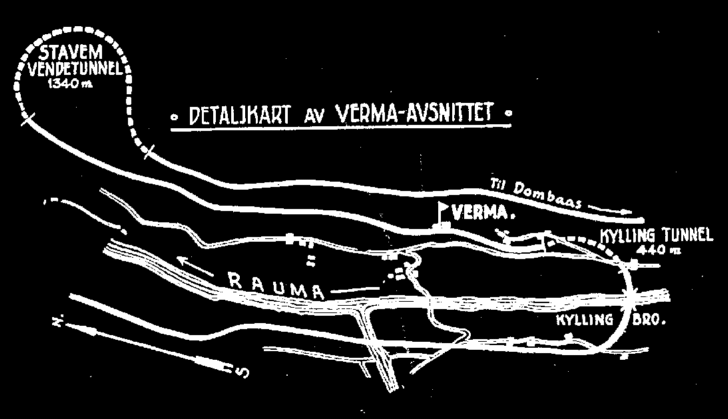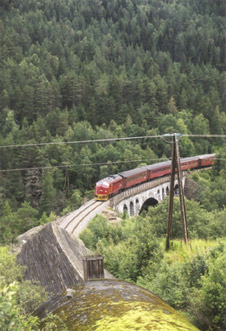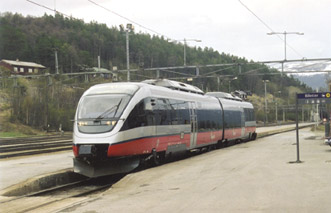
Map of the location.
The Kylling bridge and the tunnel is to the right
The former station in the middle and Stavem Tunnel to the left.
Verma modelling ideas.
In modelling sence Verma is very much like Blausee-Mitholz but some prototypic "down scaling" of it all. The line is single lined, unelectrified, and the trains battleling the grade is more typical in size of what is practical for modellers. This means 5 passanger cars or less and up to 18-20 freight cars behind a pair of diesels.Typical trainsets

A typical passanger run in the lates nineties, a venerable Di3 with a BF12 combine and trhee B3 passanger cars. Today you can model this modest consist with DI3 from Märklin, Heljan or Roco with passanger cars from Lima.
< In later years, The most typical passanger train was a Di3a engine and a BF12 combine and a pair of B3 class coaches. In H0-scale this rather easy to produce. The cars are made in model by Lima and depending on your creditcard credit, there are a number of alternatives for the Di3. Most exclusive, is the limited number brass model presented by NMJ. Marklin has produced a slightly shortened version, and a number of various versions of it was sold by NMJ. Heljan is making 3 versions of scale Di3.s. And Roco will be making a Di3b during fall of 2001. Untill year 2000, there was offered a night service with a pair of WLAB-class sleepers. Lima has announced that they will produce a model of these in 8! different versions in 2001.

The new, sleak Bombardier built Talents, of NSB BM93 class handels all passanger runs on the line. Bm 93.s are used also on "Ole Tobias" runs on Nordland line and on Rörosline.
The use of this equipment stopped in year 2000. Today, BM 93 is used on all passanger trains, a 3 car version of the Talent modeled after DBAG is produced by Brawa in H0- and N-scale.
Freights are like much of modern freighttrains is dominated by containers from and to the port of Åndalsnes and VTG 4 axle tankcars from VTG and various cars like Hbis 2 axle all door cars. The freights were hauled by a doubleheaded DI3.s but as the engines were withdrawn from freight service, they were replaced by the new centercabs of Di8.s. Today, No models of DI.8.s has been announced.
And how about the actual layout?
Still this layout modelled inch by inch would be huge, and unserviceable. But decreasing it to more practical size and suddently we got something. First, We could have the yard closer to a narrow edge of the layout. Second, replace the trackage on from Stavem and turn it in to an helix. But I would model it by modelling only the first bend, and let the track continue after the yard to left, crossing the river and continue on a rocky shelf further toward the grade to Dombås. By making the layout in to U-shaped layout. with the operator(s) in the middle.OK, you might loose some of the actual sites most intersting feature. But by giving the layout, much attention of features and details, you will make very convincing model. The area has a scenery that is very hard to overdo. You got a river gorge with rapids and waterfall big mountains with picturesque old farms with sheep on the fields. If you are in to scenery and like rockcarving or by casting mountains with molds. The layout would make a masterpiece.
Lessons learned...
There is allways more you learn from sites like this by just observing. There is allmost no way anyone can model a certain site selective compressing in any scale larger than Z. But there are certain ways to do it by useing smaller than scale buildings and scenic features closer to the background, or readjusting radiuses of the curves. Or just useing shorted versions of the actual buildings or planned kits on the site.Using smaller scaled buildings in the background works best when:
- They are placed above eye level, when looking upward, we seem to be have harder to estimate the distance. Remember placing details like cars and figures of same scale.
- By having sharp curves in tunnels or other unseen sections, and broader ones where the track is viewed. European models are engineered to work on even 15 inch radius!
- By concentrating on fewer scenes. Most of the layouts I have seen has tryed to pack to many features. On some extremes, I have seen a short freight entering a yard, while the 15 car train is middle of leaving the yard before a number of miles or kilometers away.
- Place the railroad to more ideal viewing height, maybe close to the height of your shoulder. Let the landscape or manscape (buildings) dominate the trains.
- If your layout is a shelf type, and you do not want to loose depth. If you are modelling mountain or a large city scenery, let the top of your hills or buldings be over your eye level. If this not possible or you are into flatland modelling, you can use fences, and bushes directly clued to the backdrop to hide the transition. Remember the mother nature itself is never flat. Use low rolling hills that drops slightly to the backdrop. Try to locate the rivers crossed by the bridges to the corners and curve the river towards one of the walls. And discuise these with a bridge and small mirrows...